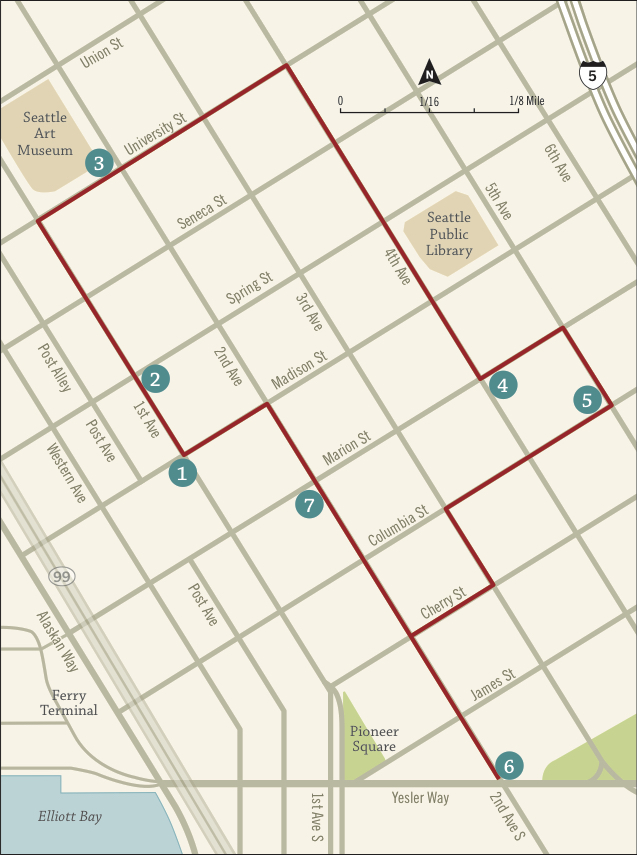One of the challenges of writing book of walks in Seattle is that the city changes. Buildings go up. Buildings get taken down. Roads are closed. Paths change. I have been pretty lucky in the walks I chose, except for one. One of the buildings (the base of the Rainier Tower) that I discuss in Walk 3 – Stories in Stone was torn down. Below is the fix for that walk, which we were able to incorporate in the third printing of the book.

The change begins on Page 42 with the directions to Stop 4 and continues to stop Page 44 and the directions to Stop 6. Directions are in Bold.
Walk two blocks east to Fourth Avenue, turn right, walk four blocks south on the east side of the street, and cross Marion Street to the brick Rainier Club (810 Fourth Avenue). Turn left to look at the retaining wall that stairsteps up Marion.
(4) The cream-colored stone atop the brick walls of the Rainier Club is the Salem Limestone, quarried near Bedford, Indiana. It became popular following the 1893 World’s Columbian Exposition, when the fair’s White City helped make white the color for buildings. As far as I have been able to determine, the Salem is the only stone used in all 50 states, including structures such as the Empire State Building (amazingly, the hole where the stone was quarried still exists as no other stone has come out of it), the Pentagon, and more than 750 post offices. (The Salem also plays a central role in the movie Breaking Away.)
Deposition of the Salem occurred 300 to 330 million years ago in a shallow, clear, tropical sea, when what we think of the Midwest looked like the Bahamas. The warm waters supported a diverse range of swimming, crawling, and bottom-dwelling invertebrates. After dying their bodies collected in a watery cemetery on the sea floor, eventually solidifying into a 40-to-100-foot-thick stone menagerie. This matrix of corpses formed a limestone that cuts cleanly and evenly in all directions.
To see some of these fossils, look at the limestone blocks atop the retaining wall. The most common recognizable fossils are 1/8- to 1/3-inch-wide discs of crinoids, a relative of starfish and sand dollars that resemble plants with a root-like base, a flexible stem made of stacked discs, and a flower-like body. Another common fossil is from a colonial animal known as a bryozoan, which looks a bit like Rice Chex cereal. Wave action from long ago tides broke up most of the shells from the animals that plied the sea but careful investigation also reveals brachiopods, which look like clam shells, and ice-cone shaped corals.
Continue east on Marion one block to Fifth Avenue, turn right and walk to the F5 Tower (801 Fifth Avenue) at the end of the block.
(5) Like Rome, Seattle was built on seven hills. Both cities also share a building stone: a type of limestone known as travertine. Coincidentally, most of the travertine used in Seattle came from quarries in Tivoli, about 20 miles east of Rome. These quarries provided stone for the Colosseum and St. Peter’s Colonnade,in Rome, as well as the Getty Center in Los Angeles, the best known travertine-clad building in this country. All of the rock from the quarries formed less than 200,000 years ago with a peak around 80,000 years ago, making this some of the youngest stone in the building trade.
Unlike the Salem Limestone at the previous stop on the walk, travertine does not form in the sea. Instead, it precipitates from calcite-rich water expelled from springs or in caves. A modern example is Yellowstone National Park’s Mammoth Hot Springs where hot water rises through cracks and emerges in pools. When this occurs, the calcite in the water settles and accumulates layer upon layer. It can occur so quickly that a half-inch-thick bed can form in a single year, as opposed to marine-deposited limestone, which takes thousands of years to deposit an inch of calcite.
The stone panels in front of you are the bedding planes, or the area where the calcite accumulated. Small honeycombs cover many panels. The holes were once gas bubbles, which were coated so quickly in calcite that they turned to stone. If you look at the side, or edge, of the panels, you can see bedding planes.
Builders used travertine indoors and outdoors in Seattle, though no other building uses this style of bedding plane panels. All others use panels cut perpindicular to the bedding; these panels look a bit like layered Swiss cheese. You can see this type of panel clearly on the walk to the next stop, at the Pacific Building (720 Third Avenue). In other structures, like the Washington Federal Savings building (425 Pike Street), workers filled in the holes in the bedding. This is for preventative maintenance. In a colder location, such as Boston, water seeps into the cracks, freezes, expands and breaks the rock. Seattle’s moderate winter climate, however, has little effect on the travertine.
Turn right on Columbia Street, cross to the south side, and walk west to Third Avenue (location of Pacific Building). Turn left on Third and walk south to Cherry Street, turn right, or west and continue one block to Second Avenue. Turn left at Second and stay on the east side until you reach the Smith Tower (502-508 Second Avenue) at Yesler Way.